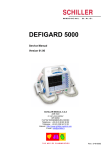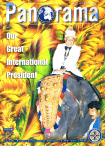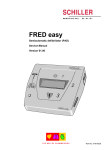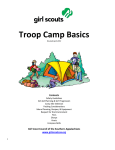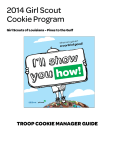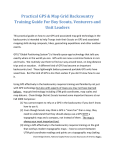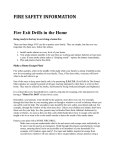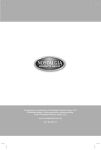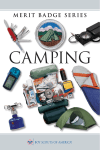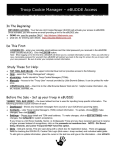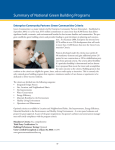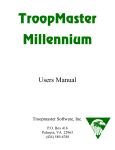Download Site Use Instructions
Transcript
II: Hidden Valley Site Use Instructions A. Location and Access 1. Location: 3420 W. Bob Billings Parkway (15th St). The entrance is west of Kasold, on the north side of BB Pkwy., next to the church parking lot. 2. Drive-in Access is through the red farm gates that are kept chained but not locked. Further access is through a coded padlocked gate. The code will be given to adult users through the reservation process, and should never be passed on to others, including youth. 3.Walk-in Access for our Presbyterian neighbors is through a gate off their back parking lot with a sidewalk to Redbud Shelter. A registration box for hikers is on the fence railing. B. Fees and Reservations 1. Fees: there is no fee for Douglas County Girl Scouts 2. Fee categories for non-Girl Scout Group Use of Camp: a. Schools and Youth Organizations: Free for site use only….$10 for cabin access/use. b. Family: $15 for site (under 25 people) plus $10 for the cabin. c. Non-profit organizations: $25 for site (under 50 people)….plus $10 for cabin. d. Companies/Businesses: $50 for site (under 50 people) plus $10 for cabin. e. Large Groups: over 50 people. Approval of event and required fees will be determined on a case-by-case basis. 3. A Damage Deposit of $50 will be collected from groups under 50 and $100 for larger groups. a. Deposit will be held until inspection of the site by the Site Manager. b. Instructions will be given by the Site Manager after deposit is paid and before access/keys are given. c. Reservations will be made through the website in accordance with posted scout priority. d. Fees must be paid in advance with separate checks for deposits and fees. 2. Reservation Procedures: Reservations for meetings, hikes, cookouts, nature study, overnight camping, and use of site-specific areas and facilities are to be made through the website at www.lawrencehiddenvalley.org or by calling the reservationist. Requests for equipment and tents are also made through the website (see Equipment Checkout Form, Sec.III, A, 3). All site visits must be recorded. Once your reservation has been confirmed, you will receive access codes and other pertinent information. Please note: a. All MINORS VISITING THE SITE MUST BE ACCOMPANIED BY AN ADULT. b. Reservations by Douglas County Girl Scouts are always given priority. Reservations by Girl Scouts outside of Douglas County or non-Girl Scout groups cannot be scheduled more than 60 days prior to the event. Non-GS groups must sign the “Hidden Valley Usage Agreement” located in Sec. III, A3. c. If the reservation is for an overnight, all Girl Scout leaders must show a copy of their Council “Camp Request/Non-Council Site” form before reservations are finalized. d. The only people permitted to use Hidden Valley are those who have made a reservation or are there for approved maintenance work. Lawrence Hidden Valley Committee, Inc. Board members and members of the Friends of Hidden Valley, Inc. are permitted to hike the grounds, as outlined in the Friends “Hiking Procedures” brochure, which is updated annually and sent to all members (see Sec. III, J) e. Due to liability issues, all non-Girl Scout individuals who register to visit the camp must sign the single page “Assumption of Risk/Hold Harmless” form (Section III, A, 2). Non-Girl Scout groups must sign the four page “Usage Agreement” (Section III, A, 1) and show proof of liability insurance. C. Safety & Emergency Procedures 1. General Safety Guidelines: Always follow GSUSA safety guidelines as described in Safety Wise. If in doubt - check it out. . First Aid: groups should bring their own first aid supplies and have a designated trained first aider as required by Safety Wise. b. Explain and use the buddy system; know where your kids are going and set clear rules and boundaries if they are exploring on their own. Plan together how they will signal for help. If they should encounter a stranger, they should immediately find and tell an adult. c. Get familiar with the camp as a group. Decide where to go for help and how to leave in case of an emergency. Pick a place where everyone will meet and conduct a practice drill. In case of fire, everyone should walk up the gravel road to Presbyterian Manor or the church lot. d. Be aware that the camp is not like your backyard or a groomed park. The woods are thick, trails are uneven, and many potential hazards exist, such as rocks to trip on, thorns, poison ivy, ticks, chiggers, snakes, and other wildlife. Be aware of your surroundings. Always wear durable and totally enclosed shoes (no crocks, sandals, half shoes, etc.). Shoes must be worn at all times while visiting the camp. e There are no phones at the camp, but a telephone book is in the cabin. Cell phones are advised. f. Bridges can be slippery, especially when wet. Use caution. g. Yellow plastic ribbons indicate poison ivy is nearby. Orange ribbons indicate a hazard to avoid. Blue ribbons identify recent tree or bush plantings that need to be protected. h. When camping overnight, chain the front gate and padlock the 2 nd gate to secure the camp. 2. Severe Weather Procedures for Hidden Valley Camp Troops should be prepared for all weather. Dress appropriately with weather changes in mind. There is a weather radio available in the cabin on the kitchen shelf. a. Rain: Rain flys are available for checkout. In case of heavy rains, troops should share the cabin or yurt. b. Flooding: the creeks can quickly flash-flood and cover the bridges. Stay out of the creeks during rain events. c. Thunder/Lightning: troops should seek shelter in the cabin. No other building will protect you from lightning. d. Tornado: In case of tornado, small troops can retreat to the basement of the Universally Accessible Composting Toilet (lower backside access). The key is on a yellow ring in the kitchen cabinet drawer. Be prepared and take time to look it over before you need to use it. The small, dark room is often filled with cobwebs, which you should clean out beforehand. Bring a flashlight. The best shelter for tornados is the basement of Presbyterian Manor, accessed through the gate near Redbud Shelter to their back door, which opens by a code after business hours. If you are camping during tornado season and inclement weather is forecasted, leaders should contact the Manor’s office (785-841-4262) prior to 5pm to discuss procedures and get the code. Due to the skylights, the cabin is not tornado proof and should only be used if unable to reach the UACT storm shelter or the Manor basement. Stay away from glass windows and skylights. If you are outside and a tornado is upon you, seek immediate shelter in a low lying spot other than the creek. Please review the GSUSA “Severe Weather Safety for Girl Scout Camp” located in Section III, G. D. Parking and Driving within the camp: Observe posted signs for parking and driving. “Authorized Vehicles” refers to Girl Scout or group leaders and their first aiders. 1.The main parking lot is beyond the second gate, next to Evelyn’s Attic (the equipment shed). Cars may park on either side of the lot. Approximately 30 cars can be accommodated if parked close together. 2. For large events, the grassy area just inside the first gate can also be used for parking in dry weather. Please consult with the Camp Manager. 3. Parking at Arcalooka Cabin: To allow space for emergency vehicles, no more than 2 cars should ever be parked in this lot: typically the leader or assistant and the First Aider. The car of the First aider should be parked facing outward. Cars carrying heavy equipment may park here on a very temporary basis to unload. This lot is not for pickup and drop off of scouts. 4. Mary’s Meadow parking: “Authorized vehicles” of groups/troops using Mary’s Meadow, Dogwood Forest and westward sites, may park in the lower gravel lot at the bottom of the hill. No more than 3-4 vehicles may park here, except on a very temporary basis to unload supplies. Do not block the chained gate as emergency vehicles must be able to enter the meadow. No driving is allowed beyond this point without expressed permission from the Camp Manager. 5. Driving: proceed cautiously and slowly (10 mph) on the road to the cabin. It is a single lane. Be prepared to back up if you meet an approaching vehicle. Do not drive on the grass to pass. Only authorized personnel (leaders and their assistants) may drive down to the cabin or Mary’s Meadow. 6. Parents attending troop events should park in the main lot and walk to the event. It is the responsibility of the leader to inform parents NOT to drive down to the cabin or meadow to pick up their children. Walk the children back to the parking area. E. Trash: There is no trash pickup at the camp. Bring your own trash bags. All garbage (including excess food, plate scrapings, grease, aluminum foil, etc.) must be removed upon leaving; never leave garbage in the sink drain, buried, in fire rings, nor in the latrines. F. Water: City drinking water is available in the cabin and at five hydrants located across the camp. See map for locations (Sec. III, H). Cabin water is generally turned off during winter (check with the reservationist). Hydrants are freeze protected and available year round. G. Toilet facilities: There is no sanitary sewer system at the camp, and no flush toilets. There are three other types of unique toilet facilities for your use: latrines, a composting toilet, and portable chemical toilet. The latrine (outhouse) should be the primary toilet used. Each group is responsible for thoroughly cleaning and closing up the toilets/buildings they used at the end of their stay. Each facility has different requirements. Detailed use and cleaning instructions are posted in each facility and in the Site User Manual (in the cabin). Make cleaning a part of your kaper duties, including sweeping, mopping, cleaning the seats, closing the lids, removing trash and latching/locking doors. Bring your own toilet paper, hand soap, or hand sanitizer. Handwashing units (spigot jugs to be filled with rinsing water) are available through equipment checkout and are also in the cabin. Toilet paper is the only waste to go down any toilet. Sanitary disposal bags are available in the cabin to place in trash receptacles in each stall. Remove these during camp clean-up. All supplies for use and cleaning (buckets, Clorox, gloves, brushes, sanitary disposal sacks, hand-washing unit, and sometimes left over toilet paper) are in the cabin—NE corner under the bulletin board. Brooms, mops, bucket and Lysol are in the cabin cubby hole. 1. Latrines: There is one 3-hole latrine (outhouse) near the cabin that is unlocked at all times and should be the primary toilet used. Be sure seat lids are down and doors closed and latched after each use. 2. Universally Accessible Composting Toilet (UACT). This toilet is wheelchair accessible and is located at edge of the cabin parking lot. The building is kept locked—blue-coded key is in the cabin kitchen drawer. This is a limited use toilet not intended for large groups. Anyone who is handicapped may use it at any time. Otherwise, troops should limit their use of the UACT to after dark, as there is a (solar operated) light switch on a timer inside the door. Use and cleaning instructions are DIFFERENT than the latrine…please carefully read the instructions posted inside. Add one scoop of flusher material at the end of your stay, and lock the door. 3. Portable chemical toilet: Located in Dogwood Forest, it is kept stocked with toilet paper. It is not locked. To clean, use the hose from the hydrant next to the treehouse to hose out entire inside. Remove trash and latch the door shut with a stick before you leave. H. Trails (maps available in the cabin or on website) 1. Do not blaze new trails. No wheeled vehicles, with the exception of wheelbarrows and wagons, are allowed on the trails. 2. Trails are kept clear of brush for single file hiking. You may cut back encroaching growth where needed, especially honeysuckle. Trails on the eastern third of camp are fairly level and wood-chipped. You can mulch the eastern trails where needed as a service project any time. Trails on the western third are more hilly and primitive and are not wood-chipped. Expect to duck down or climb over downed trees. 3. Off trail hiking is not forbidden, but do so carefully and watch out for poison ivy which is kept under semi-control along trails and unit sites. I. Sites There are 14 distinctly different unit sites (small clearings in the woods with fire rings and wood piles), and several large open spaces available by reservation for meetings, cookouts, and campouts. They are mowed seasonally as weather and usage determine. Troops/groups may reserve any facility, unit site, and area. Users are responsible for familiarizing themselves with procedures for using each facility, and for thoroughly cleaning up. A Standard Operating Policies and Procedures manual in the cabin (white binder located on craft shelves) contains detailed user information and instructions for all areas of the camp…please refer to it. 1. ARKALOOKA CABIN: The cabin is named after a Cherokee Indian who held title to the property for a time in the early 1800's. Built of concrete block with brick facing and a concrete floor, it has two covered patios, skylights, and fireplace. Cabin furnishings include two redwood picnic tables with benches, tables, shelving, heaters and a kitchen. a. Safety: Please be prepared to temporarily share cabin space with others if weather becomes inclement. 1) A regulation fire extinguisher is on the north side of the kitchen cabinets. 2) Smoke detectors are over each door and on the east and west walls. You should check them before lighting the stoves, heaters or fireplace. Extra batteries are kept in the kitchen drawer. 2) Storm preparedness: due to the skylights, the cabin is not considered safe during tornadoes. A weather radio is located on kitchen shelf . Remove batteries after use. (See Section III, I, Severe Weather Preparedness.) b. Solar-operated lighting is inside and on porches…switches are at the doors. There is no other electricity and no outlets. Fluorescent lanterns or flashlights are recommended as backups. Do not use kerosene or other flammable lanterns in the cabin. Be conservative of our solar power. c. Ceiling fans in both rooms are solar-operated…switches in the south-facing cubby of the hearth. Only adults should operate the fans. Instructions are posted. d. Cabin Heating: consists of two propane heaters. Pilot lights are kept on for your convenience; the knob must be turned to ON position to turn furnace on. Lighting instructions are on the lower inside panel of each furnace and in the Site Users’ Manual, and the thermostat is on the wall next to the furnace. Remember to turn knob back to pilot position when you leave. Please conserve our propane gas…it is expensive. Safety: When heaters are in use, children and adults should be alerted to their high surface temperature and should stay away. Do not place clothing, sleeping bags and other flammable material on or near the furnace or obstruct the air flow. IF YOU SMELL GAS, do not light anything, touch any electrical switch, or use a phone inside the building. Immediately go outside and call our gas supplier: Heetco, at 843-4655, and the Camp Manager. If you cannot reach them, call the fire department. e) Cabin Fireplace: Keep the hearth clear of wood and miscellaneous supplies. Before using, remember to open the damper by pulling down and engaging on the Hook. After use. release to close. Firewood is kept near the south door of the cabin and in the outside race east of the cabin. Do not stock wood on the brick porches. Ashes are to be removed when cold to the touch and placed in the metal can marked "ashes." Return half-burned wood to the woodpile and sweep and clean the fireplace and hearth. f) Windows: wooden shutters cover each window and are locked with padlocks. The key is located in the kitchen drawer. A stool is available inside the cabin to unlock padlock. Keep padlocks on hook (don’t relock), loosen shutter post with Allen wrench (located on the key ring), lift up shutter and secure post to S-hook in rafters. When closing, be sure to tighten shutter posts with wrench. Some padlocks need to be turned with key to relock. The double- hung windows can be raised or lowered. g) Kitchen Instructions: 1) Stove top and oven must have gas turned on (valve on wall behind stove) and pilot lights lit with matches. Instructions are in the Site Users Manual. 2) Sink/water: The cold-water sink does NOT have a waste disposal. When washing dishes, be certain to strain food particles from waste water. Add these particles to the garbage you carry out. Grease needs to be drained into containers. POUR HOT WATER DOWN THE SINK AFTER EACH DISH WASHING. Water to the cabin is turned off during the winter months to avoid freezing pipes. The outdoor hydrants are available year-round. 3) Kitchen supplies: the kitchen is fully stocked with basic cookware, pitchers, and eating utensils for INDOOR USE ONLY. Do NOT use these on fires. Everything must be washed and returned to the cabinets. h) Craft & Game Supplies: the shelves are fully stocked with all sorts of craft tools, supplies for troop use, and other resources. Please keep these supplies organized. Do not donate supplies unless you can fit them in an existing container of similar materials. Please discard all dried up pens. ALL paper supplies must fit in the large rubber tub below the shelves. i) Cleaning the cabin: leaders are responsible for ensuring that the cabin is completely cleaned, all trash and personal items removed, gas shut off to stove, furnaces turned to pilot, lights and ceiling fans turned off, and windows and doors locked after each use. Table tops and floors should always be cleaned. Users will be emailed a cleanup check-list with their reservations, and it is posted on the bulletin board as well ( “Before you Leave”). Please incorporate the cleanup into your kaper duties. If needed, the leader should remain to finish up. If not properly cleaned, leaders may be contacted for further cleaning and groups may lose their deposit. 2. SHELTERS: two roofed shelters with concrete flooring and benches can be reserved. Redbud is conveniently located off the main parking lot, making it an easy location for meetings. It also has a large picnic table and a fire ring. Southern Shade is in the back yard of the cabin and can be reserved in conjunction with the cabin or alone. La-Ka-Hi-Va fire ring is nearby. Shelter floors should be swept after use and hosed down of any spills as needed. 3. FLAG POLE HILL: is the tall grass prairie just west of the main parking lot. The perimeter is kept mowed, as well as a central path to the large mowed area encircling the “Singing Tree” and flagpole. There is also an adjacent fire ring (Oginali). The area is great for easy camping due to its proximity to equipment and parking. The mowed circle is good for games and other group activities, and its circle of sitting logs on the SE edge of the prairie suitable for meetings. 4. MARY’S MEADOW: is the large meadow at the bottom of the road, perfect for large group activities and tent camping. No driving is allowed beyond the gravel lot. Mary’s Meadow features wide open spaces, a picnic spot, several unit sites tucked into adjacent woods, challenge course structures, and the wetland. 5. THE GATHERING PLACE: is the fire ring in Mary’s Meadow encircled by three picnic tables, one of which accommodates a wheel chair. This area is great for meetings. The small, raised fire ring is best suited for stick cooking and “singing around the campfire”. A long wooden platform to the east (a former bridge) is perfect for skits. 6. WETLAND: In 2006, Friends of Hidden Valley created a small wetland in a perennially wet area of Mary’s Meadow. It is filled with tadpoles and lively frogs, small guppies, and many species of aquatic insects and plants, If you look carefully, you can find animal prints in the mud. A wildlife observation blind can be accessed from the east and via a path from Southern Shade shelter. An exploration kit, complete with rubber boots, nets, strainers, observation containers, ID cards, etc. can be checked out through the Camp Manager, 841-3567. 7. DOGWOOD FOREST: is intended to provide more adventurous opportunity for older scouts. The area has a water hydrant, portable toilet, a climbing tower, tree house, yurt, and two fire rings. The open strip is perfect for tent camping. A “Dogshed” is fully stocked with camping equipment for checkout. Use of Dogwood Forest requires the ability to pack in all needed equipment from the lower lot for there is no car access to the area. Overnight users of Dogwood Forest are responsible for cleaning the portable toilet by hosing down the inside. 8. YURT OF DOGWOOD FOREST: the yurt is a round, raised wooden deck with vinyl covering over lattice walls, a domed roof, two doors and 3 windows. The 30-foot diameter yurt can hold up to 60 people. Please allow other groups that are camping in the area to seek shelter from heavy rain if necessary. All ages can reserve the yurt for meetings, projects, etc. However, only Juniors and above may use the yurt for sleepovers. Keep in mind that it is HOT in summer, COLD in winter, and has no car access. a. Access: The yurt is kept locked. The pink-coded key is in the Arcalooka Cabin top kitchen drawer . b. Use Instructions: A yurt is a BIG tent so use the same care: 1. Do not lean against walls or hang things on walls. 2. Only adults are to raise and lower the dome with the hand crank—it only raises a few inches. Close it before you leave. 3. Use the step stool stored inside to open outside window flaps. They need to be fully raised to attach buckles. 4. Cover the floor with tarps if you are going to do crafts/activities that use: glue, glitter, paint, etc. If shoes are muddy, leave them on the mud mat at the door, but be aware of possible splinters. Use the tarps to cover the floor. 5. NEVER have a flame of any kind inside the yurt (candles, lanterns, buddy-burners, stoves, heaters, etc.). 6. NEVER use aerosol sprays inside or close to the yurt. 7. Eat inside the yurt ONLY if weather prohibits dining outside . Remember, we don’t eat in our tents either. Eat on a tarp and carefully take it outside at least 50 ft. away to shake out crumbs. We don’t want to attract rodents! 8. No sweet drinks. Only water inside. c. Cleanup Instructions: 1. Sweep the yurt and clean up anything that may have fallen on the floor. We do not want to attract animals or insects. If it got muddy, use water and a slightly damp mop to clean the floor. (Bucket, broom and mop inside yurt) 2. Leave nothing in the yurt when you leave (except for tarps and cleaning supplies already there). 3. Close and zip down the windows & wall; close dome. 4. Close doors tightly to insure they latch and the locks engage. The structure “moves”, so doors do not always line up well... you must pull on them to make sure they are locked, and don’t forget to return the keys! 9. TREE HOUSE OF DOGWOOD FOREST: Built by older scouts for their Gold Award project, the tree house is available for play anytime when not in use by others, and also by reservation for meetings and sleepovers. Sleepovers are allowed only by Cadettes and older. Tree House Rules: an adult should be present at all times; use at your own risk and use common sense. a. Only one person on the ladder at a time. b. No climbing over railing to enter or exit tree house. c. No climbing or sitting on the railings or limbs of the trees. d. Never peel bark off the tree – it kills our tree! 10. CLIMBING TOWER: built and donated by a scout grandfather for Day Camp. Tower Rules: an adult should be present at all times; use at your own risk and use common sense (check attached sign to make consistent). 1) Only one person on ladder at a time. 2) No more than four girls on top at a time. 3) Do not jump off – use the ladder to climb down. 11. UNIT SITES: are small clearings in the woods with fire rings and woodpiles (see map). Each site is available for meetings and cookouts, and several are suitable for tent camping. Please use minimum impact camping at these sites, and follow the woodpile and fire ring cleanup procedures. All sites are suitable for cooking and day use. a. Suitable for Tent Camping: Coralberry is the largest unit site and features a large flat rock for use as a table; for Sumac, Windmill & Brookside, place tents in Mary’s Meadow (The Girl Scout-built Brookside Bridge is great for “bridging” activities.) For Oginali, use Flag Pole Hill area. Dogwood Forest: place tents in open strip. b. Western Primitive Sites such as Cherokee Lookout and Thorn Hill need extensive clearing before using or pitching tents. J. Tent Camping: Tents are available for check out to properly trained adults. (See Section II for reservations and site-specific descriptions) Do not set up tents under tree branches or near the fire ring. Be sure to chain the outer gates and lock the padlocked gates during overnights. K. Outdoor Fires & Woodpiles: 1. You must have a reservation to build a fire and must be accompanied by an outdoor- trained adult. Fires are permitted only in the (19) established fire rings. Do not establish new fire rings and DO NOT DIG holes or trenches in the fire ring. (Refer to the Woodpile and Fire Rings flyer in the Site Users Manual.) 2. All fires require a bucket of water and a rake, and the ring should be raked clear of all vegetation (grass, leaves, etc.) BEFORE you start your fire. 3. No outdoor fires are allowed when burn bans are in effect within the city. Burn ban notices will be posted on Evelyn’s Attic and the cabin, or check with local authorities (fire dept). 4. Charcoal fires are permitted in fire rings, however, NO charcoal lighter fluid or any other type of liquid petroleum can be used to start wood or charcoal fires. 5. A stocked woodpile of large fuel is at each fire ring--take from the top, which is the older wood. Keep the woodpile organized. Throw rotten wood into the woods. Tender and kindling can be collected from the woods. To prevent wood diseases from entering our area, do NOT bring in wood from outside the camp. You may place tarps over your woodpile in advance if rain is forecast. 6. To put out your fire: sprinkle it with water and rake ashes until completely out. Submerge wood in the bucket of water. Do not use dirt to smother the fire. It is safe to leave only when you can touch all areas of the coals with the palm of your hand. 7. Users must clean up the area: half burned wood can be returned to the woodpile, which should be straightened out. COLD ashes and charcoal should be spread out within the ring and the rocks straightened out into a neat 10-foot circle. L. Natural Resources & Other Miscellaneous Rules 1. Observe wildlife but do not disturb it. Rocks and most plant life should be left in its natural state and undisturbed, with these exceptions: a. Leaves, flowers, seed pods, etc. can be collected for badge work, crafts, ceremonies, etc., with the following rule: collect only from abundant species and always leave much more than you collect. b. You may clear branches overhanging trails and encroaching on unit sites. c. Honeysuckle is not desirable and help removing it is appreciated. d. Lashing may be done, but must be taken apart and returned to the woods. e. Rocks may be moved or lifted to look for insects, but always replace them. f. Temporary holes can be dug for certain activities, but must be filled back in. Check with the Camp Manager before digging. 2. Natural Habitats of Hidden Valley: there are four main wildlife habitats to explore at Hidden Valley. The Friends of Hidden Valley have developed “Habitat Discovery Packets” for leaders, to assist in exploring the various ecosystems. Check with the Camp Manager for more details. a. Prairie: the prairie of Flag Pole Hill & the Friends Memorial Butterfly Garden highlight native grasses and wildflowers of the plains. The butterfly garden is great for ceremonies. Plant identification cards are in the cabin hanging on the Butterfly Garden exhibit. b. Woods: numerous trails crisscross through the woods, allowing exploration of trees, shrubs, and the animals that reside there. Look for small, round metal signs on 20 trees and match them up to the tree trek guide. c. Wetland: explore the wet’n’wild critters and plants of the wetland using the Wetland kit, available by checkout through the Camp Manager. Wading with shoes/boots is permitted but no swimming is allowed. d. Streams: several small creeks that start on the east side turn into fairly large streams in the valley. Take the “Stream Walk” that begins at Evelyn’s Attic and explore how it has changed over time; look for fungi, shale and glacial rock and aquatic critters. Access streams ONLY at gently sloping banks, to prevent erosion problems. 3. Dogs can disturb wildlife and other visitors, or encounter thorns, poison ivy and other hazards, and therefore are not recommended on site. IF you bring a dog, you must follow city rules: they MUST be on a leash and attended at all times and you MUST pick up their waste and take it with you. 4. Fireworks, fire arms, BB guns, air guns, tobacco, illegal drugs and alcohol are prohibited at all times. M. Equipment: Procedures and Lists A full line of camping and cooking equipment is available for troops to reserve and check out, including large kitchen storage boxes, tables, tarps, games, tools & tents. An Equipment list/checkout form is available on the website . Reservations for checkout are made by calling the equipment chair through the website: [email protected]. It is up to the leader to make sure all equipment is returned cleaned and in good condition. Only local Girl Scouts may check out equipment to be used off-site. Small 2-3 person tents are available for checkout and require a tent training session for leaders who can then instruct their scouts on proper use. To schedule tent training &/or checkout: [email protected] Ar-ca-loo-ka Cabin is also stocked with a full line of kitchen equipment for indoor cooking and eating, and craft supplies, games and books, which may be used when you reserve the cabin. Supplies include: decorative papers, yarn, cloth, paints, brushes, crayons, markers, scissors, hole punches, tape, glue, beads, wire, weaving boards, Plaster of Paris, etc. Games include balls, cones, jump ropes, jacks, compasses, parachute, limi sticks, etc. Resource books cover games, songs, outdoor cooking/recipes, wildlife, etc. Please keep these supplies organized. Do not donate supplies unless you can fit them in an existing container of similar materials. All paper supplies must fit in the large rubber tub below the shelves. N. Service Projects: Scout troops are encouraged to volunteer in the routine maintenance of their camp on a regular basis. Being involved in maintaining and improving the camp helps the girls become better stewards of the land and more vested in their camp. Special projects are also available for older girls or troops wanting more involved projects, including possible projects for Silver, Bronze or Gold Awards. A seasonal list of projects is maintained on the website. Contact the Camp Manager: [email protected] for more details and to coordinate your Service or Special Project. Friends of Hidden Valley, Inc. also plans and sponsors four “workdays” each year in April, June, September, and November. (Dates can be found on HiddenValley’s website.) FHV provides all tools, coordinators, first aiders, and refreshments. Scout troops or individual Scouts, accompanied by an adult (does not have to be the leader), are encouraged to attend. Participants include Friend’s members, LHVC board members, and neighbors. Troops are responsible for obtaining permission slips and abiding by Safety-Wise leader/scout ratios. No registration is required, although a quick email to the Camp Manager of your intentions is helpful for planning purposes. Please bring a water bottle or cup and dress appropriately. 1. Ar-ca-loo-ka Cabin & Smoke Puff Patch: LHVC offers a free custom-made patch for local troops using and maintaining their camp. (non-Douglas County troops may earn the patch but must purchase them--$1.50 for cabin; $1.00 for puff). Patches are ordered through the reservationist. If you already have the Arcalooka Cabin Patch, you can earn a smoke puff patch to add each time you meet the 2 requirements. There is no limit to the number of puffs you can earn. Patch Requirements: a) A Fun Day (minimum 8 hours in one or more sessions) OR an overnight, AND: b) A Service Project at the camp. Suggested work time is about 1 hour, depending on the troop’s age. (Service projects already completed, Day Camp, or Spring Fling activities do not apply). You may arrange a service project to complete on your own time through the Camp Manager or attend a Friends-sponsored workday to satisfy the service project requirement of the patch. 2. The Friends of Hidden Valley Troop Reward: an incentive reward offered to troops to encourage outstanding efforts in stewardship of their camp. The reward will be a $50 check for one troop at each age level. For more information on requirements and to download an application form, go to: www.friendshv.org and follow the link to Girl Scout Forms.











